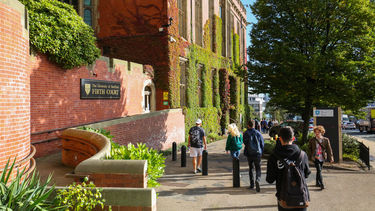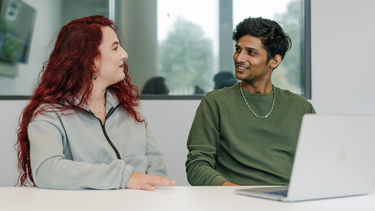Video
We use videography to tell the University of Sheffield's story in a compelling and authentic way.
Before you start
Is a video needed?
The first thing to consider is whether you really need to create a video. Is there a clear audience for this content? Is it something they are actively looking for? Even if the answer is yes, it may be the case that a webpage will suffice. If you’re not sure, contact marketing@sheffield.ac.uk in the first instance.
Who is the audience and what’s the objective?
Our videos should be user focused, always with a clear audience in mind. Make sure you set objectives before you start. Consider the following:
- What should your audience know from watching your video that they didn’t before?
- What action do you want your audience to take after watching the video?
How will you reach your audience?
Make sure you have a clear plan for how to reach your audience before you start filming. Creating an amazing video is only half the job, getting it in front of your audience is the next step. Your distribution strategy may also inform the technical specifications of how your video is created.
Planning your shoot
In house or external agency?
Our in-house content team, based in Corporate Communications can help produce video for colleagues across the University for the purposes of supporting our organisational vision and strategic plan. Please be aware that they have limited availability.
If you are unsure of who to contact or are looking to produce a video yourself, creativecontent@sheffield.ac.uk will be able to advise you on the best option for your requirements.
Video formats
Choosing the right style of video will help to effectively engage your audience and communicate your message.
Remember, production timescales vary depending on the type of video, so it’s important to identify a realistic deadline for your project.
- Interviews
-
Ideal for sharing personal experiences and insights.
- Explainers
-
Useful for making complex topics more understandable.
- Day in the life
-
Offer a glimpse into the daily life of someone at or associated with the University.
- Story based video
-
Engage your audience with narrative-driven content.
- Mini-docs
-
Offering more detail than a short video but less than a full documentary.
- Animation
-
A fun and versatile choice for explaining content when filming is not effective.
Location
For on-campus filming, using our buildings or recognisable areas as a backdrop can help reflect the University's character. Always confirm with the Estates and Facilities Management team before filming.
Filming in public areas of the city can offer a dynamic background for your video but can sometimes require more planning. Permission is not needed from passersby unless requested but those who play a significant role, like interviewees will need to sign a consent form.
Please obtain the relevant permissions before filming in public areas.
Media training
Depending on the context of the video, media training may be available to ensure those being filmed feel comfortable in front of the camera.
Filming techniques and exporting
Framing and composition
- Rule of thirds
-
Divide the frame into a grid and place key elements at the intersections for a balanced composition.
- Lighting
-
Avoid darker areas to reduce backlighting. Ensure the subject is well-lit for clarity.
- Focusing
-
Keep the main subject in focus to draw viewer attention.
- Audio
-
Avoid loud areas. External microphones help to capture clear audio and minimise any unwanted background noise.
Aspect ratio & exporting
Portrait videos are recommended at 9:16 and 4:5 aspect ratio for social media platforms and 16:9 for landscape platforms like YouTube and Kaltura.
We recommend you export your video as a high-quality MP4 file. This format ensures compatibility and quality across various media platforms.
Graphics
- Idents
-
Our outro idents is used as standard at the end of all University videos.
Our intro ident is optional. This should be used where you have a captive audience, e.g. for a presentation. We advise against using the ident as an intro when the video is primarily intended for use on social media.
- Thumbnails
-
Effective thumbnails attract people’s attention through striking visuals, provide a clear snapshot of the content and encourage people to watch your video. Our template is available to help easily create engaging thumbnails. Any fonts and colours used should follow our brand guidelines.
Elements to consider
Consider these tips to help your video work effectively.
- Voiceovers
-
Speakers should be easy to understand and speak at a moderate speed. An appropriate accent will better fit the context of the video. Our media booths are equipped with professional recording equipment and are available to book for all staff.
- Background music
-
Using royalty-free music will ensure you have proper copywriting licences for your video. Youtube hosts a large library of downloadable music and sound effects free of charge. There are numerous other libraries that offer music under Creative Commons’ flexible copyright licences, their website offers full guidance on how these can be used.
- Colours
-
Refer to our guidelines to ensure any colours used remain within our branding. Some exceptions, such as in animation may require different colours. In such cases, approval will be needed by marketing@sheffield.ac.uk.
- Transitions
-
Use transitions sparingly and keep them professional to maintain the video's overall quality and tone.
Accessibility and diversity
Captioning
High-quality captioning for helps improve a video's accessibility. Include the speaker's name and make sure on-screen text is screen-reader friendly. Kaltura's captioning software can be a useful tool for this.
Diversity and Inclusivity
Our videos should reflect and celebrate the diversity of our people. We must be conscious of achieving a broad, diverse mix of people across the breadth of our communications.
Legal
Data Protection and Consent
Refer to our guidelines on data protection and always send consent forms to those featured in your videos.
Click to read our guidance and download our consent form
Permits for Filming
Allow time to obtain necessary permissions, especially when filming in areas managed by estates and facilities, or the library. Post notices in these areas as required. For public streets, filming is generally permissible without specific permission, provided you're not using a tripod or obstructing the area.
Using drones
Before organising any activity using drones, you must gain permission from University Estates (EFM) and University Security. A risk assessment must be completed before drones are used on the University premises, whether indoors out outdoors.
Notify Security Management, Estates and Health & Safety Department by emailing:
flying-drones-group@sheffield.ac.uk
The full policy for use of drones is available on the Health & Safety website.
Find a health and safety policy - D
Contact us
creativecontent@sheffield.ac.uk















